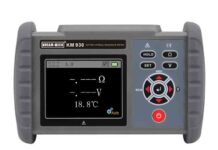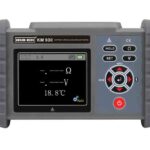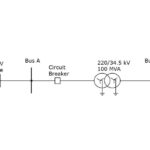
The DETWFL method uses the arrival times for the initial TW at both terminals, along with the LL and the TWLPT, to calculate the fault location. The general equation used to calculate DETWFL results is shown in (1). M is the calculated fault location, tL is the arrival time of the initial TW at the local terminal, and tR is the arrival time of the initial TW at the remote terminal.

The UHS relays also provide a calculated fault location using the SETWFL method. This is particularly useful when dedicated point-to-point direct fibre-optic (or IEEE C37.94 multiplexed communications with sub microsecond time synchronised relays) is unavailable for a given application, a single relay is installed on a radial line, or the fibre-optic channel used for relay-to-relay communications is temporarily out of service.

Field Event Analysis
This section highlights the performance of the protection elements and the fault locating of the UHS relay during an internal Phase C-to-ground fault on the transmission line which occurred in March 2024.
It was observed that the TW87 element trip 0.6 mS after TWDD asserted (the first indication of any disturbance). At the Renukoot end, the TW32 elements declared the fault to be forward direction in 60 µs, the TD32 element operated in less than 1.2 mS for the internal fault and TD21 operated in less than 3.5 mS.


In the following sections, the performance of the TW87, directional, distance, and fault locating elements are examined individually.

TW Differential Scheme
Recalling from above section, for an internal fault the local and remote TWs should have the same polarity and should arrive within the TWLPT, or 101 µs. Fig. shows the detection time of a disturbance and the TW87C output asserted for a Phase C trip due to the TW87 scheme. Fig. and Fig. present the alpha Clarke components of Phase C local and received remote TW current (TWIA.alpha and TWIAR.alpha, respectively), as seen from Renukoot end.

Fig. X.1 shows the first waves at both terminals. The two waves are of the same polarity and the time difference between them is 26.88 µs, which is well within the TWLPT.

Directional Elements
Fig.X.2 displays the delta quantities of the Phase C-to-ground incremental loop replica current (DIZAG) in secondary amps and the Phase C incremental voltage (DVA) in secondary volts. As expected for a forward fault, the incremental replica current and voltage are of opposite polarity, leading to a TD32F assertion in 1.15 mS.


Fig.X.3 shows the Alpha Clarke components of the TW current (TWIC.alpha) in primary amps and TW voltage (TWVC.alpha) in kV for the TW32 element operation. The opposite polarity of the incident current and voltage TWs results in a TW32F declaration in less than 60 µs.
Distance
The distance elements are analysed for ground fault since the fault involved was phase C- Ground, so the focuses is specifically on TD21G element. For the UHS relay at Renukoot end, the TD21 operated as expected for the internal events, TD21 element asserted in 3.45 mS. For the relay at Renusagar end TD21G did not operate though the fault was within the reach setting of the relay. Why the element did not trip for these events is analysed in next section.
Note that to get a TD21G assertion, the UHS relay must also declare a forward direction (TD32F) and meet the incremental replica overcurrent supervision (TD21CG50).
Fig. provides the operating and restraint quantities in the event report that caused the TD21AG assertion…


Fault Location
The UHS relay provided excellent fault locating for the internal fault on the line.
The direct fibre-optic channel is used to exchange 1 MHz sampled voltages and currents between the UHS relays at Renukoot and Renusagar end. Each UHS relay timestamps the arrival of the first TW associated with the local currents and received remote currents. With the arrival time of the initial TW at the local and remote terminals known, each UHS relay automatically calculates the fault location using the DETWFL method by applying the TW arrival times, along with relay settings for LL and TWLPT using the equation mentioned in above section.
The Bewley diagram in Fig. X shows the C-phase TW alpha-mode currents from the Renusagar and Renukoot terminals. The Bewley diagram provides a visualization of the TWs for the fault and allows for verification of the DETWFL result.
The UHS relays located the fault at 10.881 km from Renukoot and 18.809 km from Renusagar terminal. Fig. XX displays the C-phase alpha mode current TWs captured by the UHS relays at the Renukoot and Renusagar terminals and shows the relative arrival time difference of 26.88 µs between the first TWs at each terminal. It also shows that the initial TWs that arrived at each terminal have the same polarity (positive) and are separated by less than the TWLPT for this line (101 µs).


When time-synchronized MHR IEEE COMTRADE records from the UHS relays at each terminal of the line are opened in a single session of the event analysis software, the event analysis software allows the user to plot the Bewley diagram and automatically align the local and remote TW peaks to display the fault location relative to either terminal of the line (see Fig. X).
The time stamps for the initial TW that arrived at each terminal can also be confirmed from the fault location information in the HDR file of the MHR or TDR IEEE COMTRADE records from either terminal. Fig.XXX shows the fault location information in the HDR file from the UHS relay at Renukoot.

The fields in Fig. XXX are described as follows:
- SE_TW_Location (n = 1, 2, 3, 4) are the fault locations from the SETWFL method.
- DE_TW_Location is the fault location from the DETWFL method.
- SE_Z-Based_Location is the fault location from the SEZFL method.
- DE_Z-Based_Location is the fault location from the DEZFL method.
- First_TW_Time_Local is the time stamp of the first local TW.
- First_TW_Time_Remote is the time stamp of the first remote TW.
The information in Fig. XXX confirms that the relay automatically calculated the fault location using the DETWFL method (DE_TW_Location is 10.881 km). This result can also be verified manually by using the time difference in arrival times of the initial TW at each terminal.
Post-Fault Arching and Breaker Reignition Observed In 1 Mhz Transient Records
While reviewing the fault current profile of the C-phase, we observed an instance when TWs were launched before the fault was cleared.
Conclusion
The successful deployment of Ultra-High-Speed Travelling Wave Protection on a critical 132 kV transmission corridor at Hindalco Renusagar underscores its transformative potential in modern power systems. The substantial reduction in fault clearing time and enhanced precision in fault localisation translate into improved protection of high-value assets, increased system stability, and reduced operational risks.
The implementation has proven particularly beneficial in mitigating the detrimental effects of lightning-induced faults in complex terrains The use of TWs in line protective relays for UHS protection and accurate fault locating is gaining popularity. UHS relays with 1 MHz transient recording capabilities are providing valuable insights into power system operation. The field experience, observations, and lessons learned are similar and repeat those reported and documented by other users of UHS relays.
These may be summarised as follows:
i. Enhancement in line protection performance from UHS relays compared to phasor-based relays is decisive when related to system stability, critical fault-clearing times, improvements in system voltage dips during faults and reducing stress on primary equipment’s like generator and transformers during faults.
ii. The TW87 scheme with direct fibre between the relays operates in around 1–2 mS using conventional current transformers; it is typically tenfold faster than phasor-based line differential schemes.
iii. The TW32 element speed (pickup in microseconds) and directional accuracy, combined with the dependability and security of the incremental-quantity directional TD32 element, significantly enhance the use and speed of POTT schemes.
iv. The use of ultra-high-resolution recordings are invaluable in modern power systems highlighting significant issues, such as breaker reignition, post-fault arcing, lightning strikes, and many more.
v. With UHS relays, Hindalco and other Power Utilities has the potential to further improve the reliability and lifespan of Turbogenerators and other primary equipment’s by reducing stress on them during faults.
Future Directions
- Expansion of UHS protection across all high-risk transmission lines
- Integration with Wide Area Monitoring Systems (WAMS) for enhanced situational awareness
- Development of adaptive protection algorithms responsive to dynamic grid conditions
- Advanced fault analytics using machine learning to further optimise relay performance and system configuration.
Concluded

Raman Bajpai holds a Bachelor’s degree in Electrical & Electronics Engineering and an MBA in Marketing Management. He is currently serving as General Manager (Electrical & Instrumentation) at Hindalco Industries Limited, Hirakud (Power & Smelter). He has over two decades of experience in the areas of Protection, Control & Automation Systems, Transformers, Motors, and Instrumentation. His core competencies lie in digitalization, innovation in electrical systems, and enhancing power system reliability and stability. Bajpai has played a key role in stabilizing complex industrial power systems, contributing to improved operational reliability and safety performance. He joined Hindalco in 2008 at the Renusagar Power Division and has previously held technical and leadership roles at Siemens, HEG, and the Jaypee Group.



















